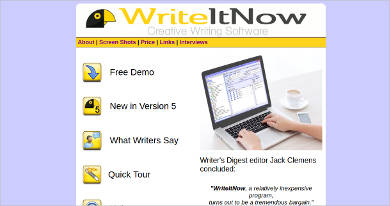

- WATCH TUTORIALS ON WRITEITNOW 5 SOFTWARE GENERATOR
- WATCH TUTORIALS ON WRITEITNOW 5 SOFTWARE UPDATE
- WATCH TUTORIALS ON WRITEITNOW 5 SOFTWARE SOFTWARE
- WATCH TUTORIALS ON WRITEITNOW 5 SOFTWARE PROFESSIONAL
In addition, it will type into just about any program you care to name. It’s closely integrated with your browser, so it can be used in WordPress. One said: I can do almost anything I need to do using Dragon NaturallySpeaking. That said, I came across several people who use DNS with Scrivener. Microsoft Word can be copied and pasted into WIN.
WATCH TUTORIALS ON WRITEITNOW 5 SOFTWARE PROFESSIONAL
I’ve not used DNS, but I see from professional and user reviews that it is compatible with Microsoft Word. I tried to do some research on Dragon Naturally Speaking and its potential compatibility with WIN. Richard, I’m sorry to hear about your accident, but I love your positive attitude. Either, or both, will definitely improve and help your writing.
WATCH TUTORIALS ON WRITEITNOW 5 SOFTWARE SOFTWARE
So, although it seems redundant to have two writing software programs, I think it is worth it to invest in Write It Now 4 for the planning and beginning stages of a novel, and Scrivener for getting deeper into the first draft and for revisions. I also like the autosave better on Scrivener and its compile feature. I like how you can easily split pages, or see only the chapters from a particular character’s point of view in Scrivener. However, when I was well into the first draft, and now that I am starting to revise, I prefer Scrivener.
WATCH TUTORIALS ON WRITEITNOW 5 SOFTWARE GENERATOR
I like WIN4’s storyboard set-up, character generator and character dynamics diagrams. I prefer Write It Now 4 when planning and beginning a novel. Until I find the time to write a complete post, the short version is that now I’ve used both programs.
WATCH TUTORIALS ON WRITEITNOW 5 SOFTWARE UPDATE
Can anyone out there help with that one? I plan to update my reviews of Write It Now 4 versus Scrivener. I don’t know about Dragon Naturally Speaking. Writing programs like this won’t work nor appeal to every writer, but I do recommend it to thriller writers and others with way too many balls in the air (hmm, maybe that is every writer).Īnd to those out there who use other writing software, like Scrivener, I’d love to hear from you and share your thoughts in the comments, below. It’s not so much a program for writing, as a program for inspiring, organizing and expanding upon ideas. Write It Now 4 also has global find/replace, a thesaurus, a character name generator, writing prompts, a timeline feature, and tabbed sections for settings, ideas, and notes among its features. The program generates a character graph with relationships, like this: Speaking of characters, I can go to character tabs I’ve created to add personality traits, important dates, relationships and more. An overall look at the storyboard showed me who was being neglected. Pull down tabs also take you to whichever chapter you need to work on next.Īnd those colors? I designated a color for each POV character. I can rearrange scenes simply by dragging them into place.Īny change I make on the story board is automatically transferred to the main writing/editing sections of the program. It also forced me to organize scenes into more manageable parts. This immediately helped me focus on the vital turning points in my story.


Instead of one long manuscript, I had to separate it into major parts. To use the story board format, I had to start thinking of my novel in a different way. The columns of color-coded boxes are chapters within those parts. The non-colored column of boxes on the left are “parts” of my book. One of my main reasons for investing $70 in Write It Now 4 was for the Story Board feature. What I didn’t know is that writing software would change my entire approach to writing a novel. I had a separate Word doc with character profiles, and another with chapter summaries, among others. I’d written my first novel in Word, using global finds to locate my last stopping point with “start here,” or “changes needed,” or highlighting my notes to myself in red. I was struggling to remember who had done what, who knew what, and did I change that yet in a previous chapter? The crocodiles were hungry to snap up anything that fell.

I had way too many balls in the air–complex plot, historical references, multi-layered characters, puzzles, action scenes, spiritual themes, challenging settings, dynamic relationships. I was a juggler on a tightrope balancing over a pool of crocodiles.


 0 kommentar(er)
0 kommentar(er)
